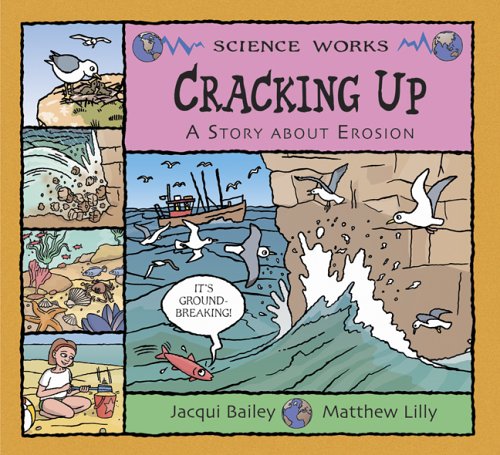-
Ships
N. Hawkes
Hardcover (The Watts Publishing Group, Oct. 28, 1999)None
-
Trucks, Tractors and Cranes
Bryson Gore
Hardcover (Watts Pub Group, Oct. 31, 2000)Cars, Trains & Motorcycles outlines the basic scientific theory behind land transport, then tackles the key subjects of how wheels and suspension work, how land transport is built, how their engines work and how they are steered and controlled. The book contains plans for a fully working car model. Trucks, Tractors & Cranes outlines the basic science theory behind construction vehicles. Each chapter contains diagrams and cutaway artwork that reveals simply and clearly how everything from a truck to a huge crane works. The book contains instructions and plans for a fully working crane model.
-
The Rock Factory
Jacqui Bailey
Paperback (A&C Black, Oct. 14, 2006)This series uses cartoon-style illustrations and humorous narrative text to make key topics in science and geography accessible and engaging. This approach encourages children to read about and understand complex ideas. R
R
-
Biology Dynamic Processes
Seymour Rosen
Paperback (Globe Fearon Co, Jan. 1, 1992)Workbook exercises and experiments guide the user to understand and explore the basic biological concepts in cells, how genes influence offspring, and the functions of the human body. P
P
-
Rockets and Other Spacecraft
Nigel Hawkes, John Farndon, Alex Pang
Library Binding (Rebound by Sagebrush, April 15, 2000)None Y
Y
-
Sun Up, Sun Down : The Story of Day and Night
Jacqui Bailey, Matthew Lilly
Paperback (Gardners Books, June 30, 2004)None
-
CRACKING UP: A STORY ABOUT EROSION by Bailey, Jacqui
Jacqui Bailey
Hardcover (Picture Window Books, March 15, 1837)This series uses cartoon-style illustrations and humorous narrative text to make key topics in Science and Geography accessible and engaging. This approach encourages children to read about and understand complex ideas. The story follows what happens when a cliff is gradually eroded by the sea, wind, rain and ice. We find out how rocks from a cliff-face eventually become the grains of sand we find on the beach. This book also contains an experiment, useful websites and an index. Reviews for previous titles in the Science Works series: 'Making science accessible and fun for younger readers is no easy task, but the author/illustrator partnership of Bailey and Lilly makes a brilliant job of it...Bright appealing cartoon-style artwork and a continuous narrative text treat each topic in the form of a story...Highly recommended' Books for Keeps, 5 star review. 'Using a clear and engaging narrative format with well-conceived and lavishly produced illustrations, the Science Works series interweaves science knowledge into a story with humour and interest' Times Educational Supplement
-
Exploring Forces and Movement
Carol Ballard
Library Binding (Powerkids Pr, Jan. 1, 2008)Discusses basic elements of force and movement, including gravity, balance, friction, air resistance, and pressure. Q
Q
-
Charging About : The Story of Electricity
Jacqui Bailey, Matthew Lilly
Paperback (Gardners Books, June 30, 2004)This series uses cartoon style illustrations and humorous narrative text to make key topics in Science and Geography both accessible and engaging. This approach encourages children to read about and understand complex ideas. This is the story of how electrical energy is generated in a power station, how it travels through pylons, power cables and wires until it reaches towns and homes. We learn how electrical current is created and how it is made safe. This book also contains an experiment, more great facts to know, useful websites and an index.
-
How Do Dolphins Communicate?
Lori MacDhui
Paperback (Powerkids Pr, Aug. 15, 2017)Did you know that dolphins have names for each other? Readers discover the amazing world of dolphin communication and more in this fun and informative book. Bringing abstract concepts to life with factual evidence, the book explores the function of life science in the natural world. Dazzling photographs will stimulate readers, and accessible language will aid developing vocabularies. M
M
-
Physical Science: Matter and Energy, Annotated Teacher's Edition
Pearson Education
Paperback (GLOBE, Nov. 18, 1999)Science Workshop Series in English and Spanish The Annotated Teacher's Editions provide on-page answers for all questions, exercises, and chart and tables, as well as helpful teaching strategirs. They also include motivatting start-up questions, suggestions for class activities, demonstrations, extensions, reinforcement, cooperative learing, and an end-of-book test with Answer Key. This program presents science concepts in areas of biology, earth science, chemistry, and physical science in a logical, easy-to-follow design that challenges without overwhelming. This flexible program consists of 12 student texts that can easily supplement an existing science curriculum or be used as a stand-alone course. Reading Level: 4-5Interest Level: 6-12 Provides a strong formula for competency with an emphasis on science and verbal skills. Reinforces concepts with a variety of exercises, such as sentence completion, matching, true or false, and open-ended questions. Builds science knowledge in a logical sequence with manageable skill introduction and lesson structure. L
L
